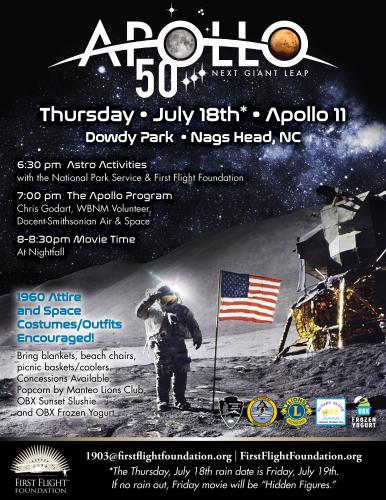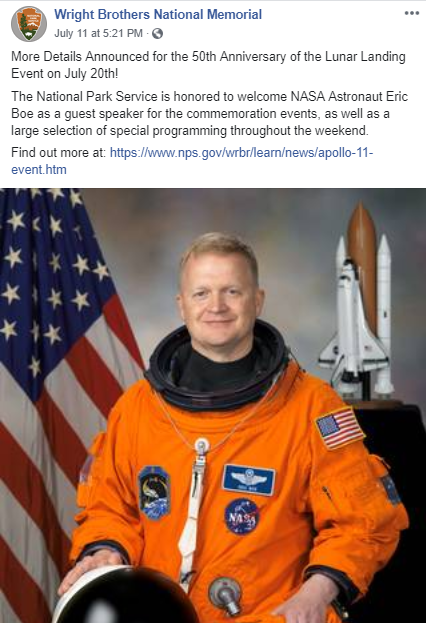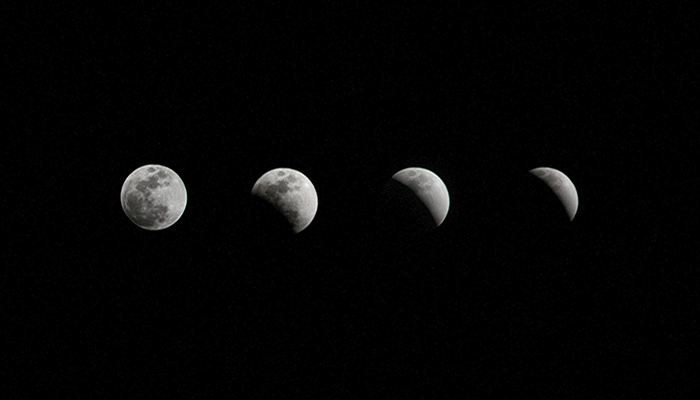The world has long been fascinated with Outer Space. It’s crazy to imagine that decades ago, the concept of actually exploring space seemed impossible when today, space exploration is a continuously growing multi-billion-dollar industry. This year marks the 50th anniversary of one of the most influential and well-known space exploration achievements: The Apollo 11 Moon Landing of July 20, 1969. Ask anyone who lived through the early stages of the Space Race and chances are, they can remember with absolute precision exactly where they were and what they were doing when they watched the news coverage of this successful launch. Even those of us born after 1969 relish the moment as astronauts Neil Armstrong and Buzz Aldrin have lived on as household names in everything from textbooks to pop culture. This month, there will be celebrations all over the nation in honor of the anniversary of this incredible event but you can celebrate the 50th Anniversary of Apollo 11 right here on the Outer Banks!
Anniversary Events
Residents and visitors will be able to celebrate the 50th anniversary of this momentous flight by taking part in various programs and events from July 18th, 2019 through July 21st, 2019. The celebration kicks off at Dowdy Park in Nags Head and the schedule of events is as follows:
July 18
- 6:30 PM: Apollo 11 Astro Activities at Dowdy Park – Ranger Program kid-friendly activities
- 7:00 PM: “Apollo 11, Final Chapter in the Space Race” at Dowdy Park – program presented by Chris Godart with the National Park Service on the Apollo 11 mission
- 8:00 PM: “Apollo 11” Documentary presented at Dowdy Park
July 19
- 10:00 AM | 11:00 AM | 12:00 PM | 4:00 PM: Sand Dunes & Moon Dust at the Wright Brothers National Memorial – Ranger program to learn about the first powered flight in 1903 and how it is similar to the Apollo program
- 1:00 PM | 2:30 PM: The Wright Stuff at the Wright Brothers National Memorial – Ranger program to learn about the legacy of the Wright Brothers
- 7:00 PM: Homemade Rocket Launch at Jockey’s Ridge State Park – Kid station to build your own homemade rocket
- 7:45 PM: Homemade Rocket Launch at Jockey’s Ridge State Park – Group rocket launch followed by Sunset on the Ridge
July 21
- 10:00 AM | 11:00 AM | 12:00 PM | 4:00 PM: Sand Dunes & Moon Dust at the Wright Brothers National Memorial – Ranger program to learn about the first powered flight in 1903 and how it is similar to the Apollo program
- 1:00 PM | 2:30 PM: The Wright Stuff at the Wright Brothers National Memorial – Ranger program to learn about the legacy of the Wright Brothers
Feature Event Schedule
Fifty years ago, hundreds of visitors gathered around for a live broadcast of the moon landing at the Wright Brothers National Memorial and now you get a chance to relive that important moment in history! Joining the celebration is NASA astronaut Colonel Eric A. Boe as special guest speaker. Not only will he be giving a presentation on his experiences but you’ll get an opportunity to meet him for yourself!
Visitors are encouraged to bring beach chairs and flashlights for the re-broadcast. Food will be provided for purchase by various food trucks on site. Visitors are also encouraged to dress up as astronauts or in 1960’s costumes. In the Junior Aviator Store, special kid-friendly activities will be provided by the NPS and NASA Langley Research Center.
Saturday, July 20 (Feature Event Day)
- 10:00 AM | 11:00 AM | 4:00 PM: Sand Dunes & Moon Dust at the Wright Brothers National Memorial – Ranger program to learn about the first powered flight in 1903 and how it is similar to the Apollo program
- 10:00 AM | 3:00 PM | 4:30 PM: Planet Walk at Wright Brothers National Memorial – Walk a scale model of the solar system on the grounds of the Memorial
- 12:00 PM: “Apollo 11, Final Chapter in the Space Race” at Wright Brothers National memorial - program presented by Chris Godart with the National Park Service on the Apollo 11 mission
- 2:00 PM: Ask an Astronaut at Wright Brothers National Memorial – Presentation by NASA astronaut Colonel Eric Boe followed by a Q&A session
- 2:30 PM: The Wright Stuff at the Wright Brothers National Memorial – Ranger program to learn about the legacy of the Wright Brothers
- 5:00 PM: Meet & Greet with NASA Astronaut Eric Boe at Wright Brothers National Memorial
- 7:00 PM: Guest Speaker Feature Event at Wright Brothers National Memorial – Feature event in which NASA astronaut Eric Boe discusses spaceflight and various NASA initiatives
- 8:00 PM: Footage of the Moon Landing Feature Event at Wright Brothers National Memorial – Rebroadcast of Walter Cronkite’s famous news coverage on the Apollo 11 Moon Landing
*Park Admission Fees for July 20th will be waived in honor of these events.
For more information about these events or for the full detailed schedule, visit https://www.nps.gov/wrbr/planyourvisit/apollo-11-50th.htm
History of Apollo 11
Following World War II, tensions between the Soviet Union and the United States led to a period known as The Cold War. The Cold War was a conflict between two politically influential superpowers in which many feared the outbreak of another war—one that could be catastrophic due to the development of nuclear weapons. As a result, political, militaristic and economic competition emerged between the two nations. One particular competition was over space exploration and became known as the "Space Race."
In 1955, both countries announced their plans to launch a satellite into space a few days apart, thus beginning a “race” between both nations to develop and successfully launch instruments specifically designed for orbit. In 1957, it would be the Soviet Union who prevailed with the launch of the first artificial Earth satellite into Space. This satellite, named Sputnik 1, orbited Earth for three weeks with a distinct radio signal that was easily detectable back on Earth. The reaction of the American public was one of shock and determination. With the increase focus on technological research, science, and engineering, a more aggressive approach was taken in order to compete in the race. A few months later, the Explorer 1 satellite was launched by the US.
In 1958, President Dwight D. Eisenhower recommended that a civilian agency be established to embrace the age of space exploration and shortly after, the National Aeronautics and Space Act was signed on July 29, 1958 establishing the National Aeronautics and Space Administration (NASA). A federal agency directing space exploration for military purposes, the Advanced Research Projects Agency (ARPA), had already been created earlier in the year.
Meanwhile, the USSR had another successful first on April 12, 1961 when Yuri Gagarin became the first human in space with the launch of the Vostok 1 spacecraft. The US responded the following month with the successful flight of the Freedom 7 in which Alan Shepard became the first American in space. The event was televised and he was celebrated as an American hero receiving the NASA Distinguished Service Medal and Distinguished Flying Cross. (In 2011, the United Nations proclaimed that April 12th would be known as the International Day of Human Space Flight to celebrate the anniversary of Gagarin’s flight).
At this point, American public opinion was in jeopardy as the Cold War was ongoing and NASA’s advancements seemed to always be one step behind those of the Soviet Union. On May 25th, 1961, President John F. Kennedy famously made an appeal to Congress stating that he believed America should commit to landing a man on the moon before the end of the decade. NASA focused on this feat exclusively and launched the Apollo program. Both the US and the USSR unfortunately suffered from early design flaws in the race to reach the moon in which astronauts from both nation’s were lost in various accidents. Ultimately, however, spacecraft flaws were addressed, missions were refined, and their persistence paid off.
On July 20, 1969, Apollo 11 successfully landed on the moon with astronauts Neil Armstrong and Buzz Aldrin in tow making them the first humans to ever land on the moon. A few hours later, Armstrong took the first moonwalk and uttered “That’s one small step for man, one giant leap for mankind,” a phrase that would be permanently engraved in American history.
To learn more about space exploration, visit NASA’s Website.
Jessie has been coming to the Outer Banks since she was just 5 years old. She loved it here so much that she finally relocated in 2018. Now her mission is to show the world that the Outer Banks is an incredible place that everyone should experience. When she isn't working, you can find Jessie hanging out with her friends, chilling at home with her awesome cat, Yoji, or discovering a new Outer Banks adventure.








